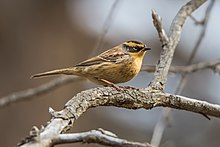| Siberian accentor | |
|---|---|

| |
| Scientific classification | |
| Domain: | Eukaryota |
| Kingdom: | Animalia |
| Phylum: | Chordata |
| Class: | Aves |
| Order: | Passeriformes |
| Family: | Prunellidae |
| Genus: | Prunella |
| Species: | P. montanella
|
| Binomial name | |
| Prunella montanella (Pallas, 1776)
| |

| |
Breeding summer visitor (ranges are very approximate)
Winter visitor | |
The Siberian accentor (Prunella montanella) is a small passerine bird that breeds in northern Russia from the Ural Mountains eastwards across Siberia. It is migratory, wintering in Korea and eastern China, with rare occurrences in western Europe and northwestern North America. Its typical breeding habitat is subarctic deciduous forests and open coniferous woodland, often close to water, although it also occurs in mountains and spruce taiga. It inhabits bushes and shrubs in winter, frequently near streams, but may also be found in dry grassland and woods.
The Siberian accentor has brown upperparts and wings, with bright chestnut streaking on its back and a greyish-brown rump and tail. The head has a dark brown crown and a long, wide pale yellow supercilium ("eyebrow"). All plumages are quite similar. The nest is an open cup in dense shrub or a tree into which the female lays four to six glossy deep blue-green eggs that hatch in about ten days. Adults and chicks feed mainly on insects, typically picked off the ground, but sometimes taken from vegetation. In winter, the accentors may also consume seeds or feed near human habitation.
Breeding over a huge area, the Siberian accentor has a large and stable population. It is therefore evaluated as a species of least concern by the International Union for Conservation of Nature (IUCN), although, as a northern breeding species, it may be affected by climate change in the long term. October and November 2016 saw an unprecedented influx of this species into western Europe, reaching as far as the United Kingdom.
- ^ BirdLife International (2016). "Prunella montanella". The IUCN Red List of Threatened Species. 2016. IUCN: e.T22718630A89519348. doi:10.2305/IUCN.UK.2016-3.RLTS.T22718630A89519348.en.
